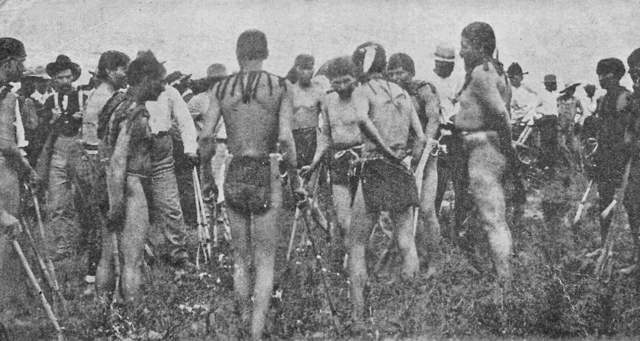IMAGE INFORMATION
EditSeveral Native American tribes such as the Choctaw, Cherokee, Chickasaw, Muscogee, Seminole and Yuchi play stick ball and the game continues in Oklahoma and parts of the Southeastern U.S. where the game originated.
Depending on the tribe playing the game, stickball can be played with one or two wooden sticks made from tree trunks or saplings of hardwood such as hickory. The wood is thinned at one end and bent around and attached to the handle to form a loop that is bound with leather. Leather strips, wattup or deer sinew are stretched across the back of the loops on the sticks to form netting so the ball can be caught and held in the cup of the stick.
Traditional stickball games were sometimes major events that could last several days. As many as 100 to 1,000 men from opposing villages or tribes would participate. The games were played in open plains located between the two villages, and the goals could range from 500 yards (460 m) to several miles apart.Rules for these games were decided on the day before. Generally, there was no out-of-bounds, and the ball could not be touched with the hands. The goals would be selected as large rocks or trees; in later years wooden posts were used. Playing time was often from sun up until sundown.
Stickball is and always has been a full-contact sport played without protective padding, helmets, and in most cases without shoes. The earlier game had very few rules and because the game was often used as an alternative to war, fatalities did occur.
The night before the game was to be played a tribal ball dance was held in which most of the community would take part. The dances consisted of conjuring ceremonies and spiritual songs and practices that were believed to bring good luck to the team. The players wore ceremonial regalia, sacrifices were held, and sacred expressions were yelled to intimidate opponents.
The medicine man performed rituals to prepare players and their sticks. One by one the shaman would take each player away from the dance to perform the "mystic rite known as going to the water" at which time the shaman blesses the game and each player receives ritualistic scratches that were said to "cause the blood to flow more freely" during the game, assuring a win for the team. In many instances, winning the game meant winning a dispute with another tribe or community.
Players decorated their bodies with paint and charcoal and their sticks or stick racks with objects representing qualities desired in the game. In addition to athletic training, strict taboos were held on what players could eat before a game. Players would fast and be banned from eating certain foods in hopes that the absence of this food would mentally, spiritually, and physically enhance the player's capability to move the team towards a win in the game.
On the day of the game, teams walked to the field and were slowed by constant rituals. Before the game, every player was required to place a wager. Items such as handkerchiefs, knives, trinkets, horses, and even wives and children would be at stake. The bets would be displayed on a rack near the spectators, and items would be awarded proportionally to the winner of each quarter. When the game was over another ceremonial dance took place, along with a large feast for the hungry players.
In 1834, after the Caughnawaga Indians demonstrated a game of stickball in Montreal, Canada, many Canadians took interest in the game. In 1856, William George Beers codified the aboriginal game into modern lacrosse.


